Unlike most asterisms, many of the Big Dipper’s stars really are physically connected. They belong to a loosely bound stellar stream called the Ursa Major Moving Cluster.
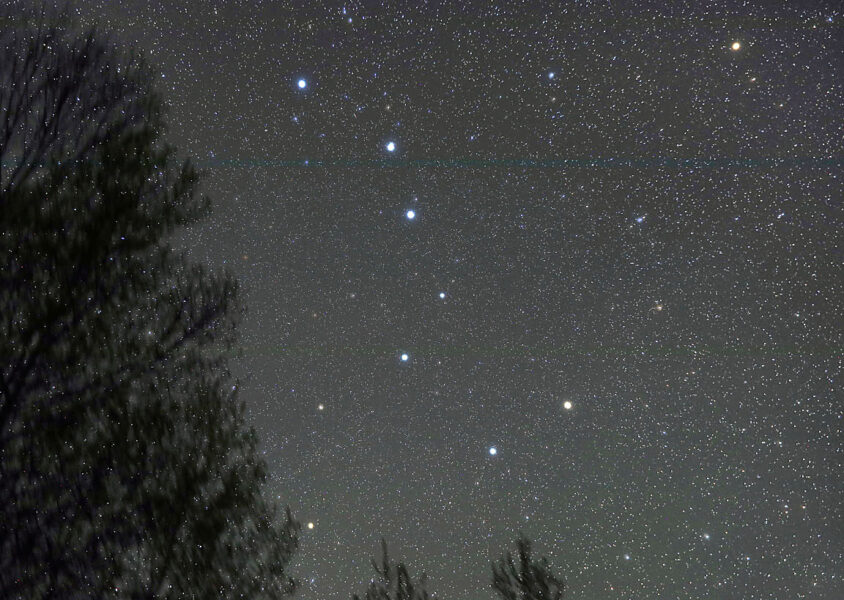
Bob King
To the uninitiated, the stars comprising Orion's Belt or the Southern Cross form such tight and distinctive patterns it's tempting to think they're physically related. Nothing could be further from the truth. Despite appearances, the stars in these groups and many others lie at different distances and only appear linked because we view them along similar lines of sight. Epsilon (ε) Cygni, the star marking the eastern end of crossbeam in the Northern Cross asterism, is a good example. Located 73 light-years from Earth, it's almost 36 times closer than Deneb, also known as Alpha (α) Cygni, at the head of the cross.
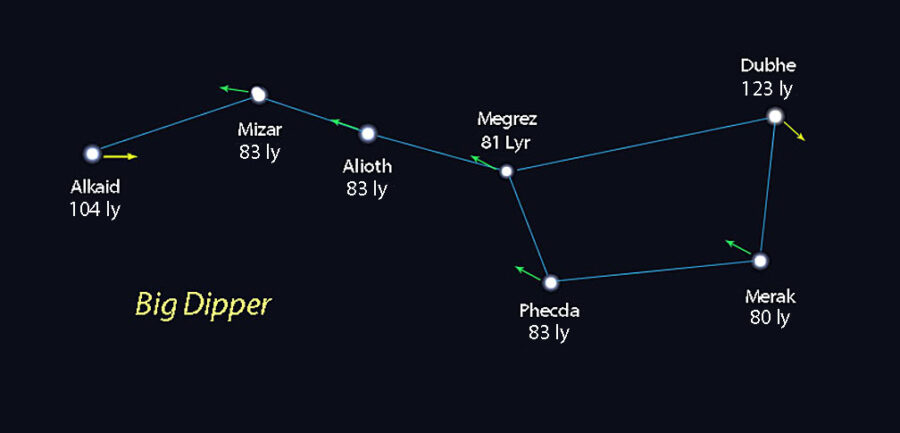
Stellarium
The Big Dipper — the brightest and most recognizable portion of Ursa Major — is an exception. If we remove Alkaid at the handle-end and Dubhe from the Bowl, the remaining five stars all lie at approximately the same distance — between 80 and 83 light-years. In 1869, British astronomer Richard Proctor discovered that they shared the same proper motion, moving in tandem to the southeast at the rate of one full Moon diameter every 16,000 years. The stars' shared distance and motion implied that they were once bound more tightly but have since dispersed into a loose confederation we know today as the Ursa Major Moving Cluster (also referred to as the Ursa Major Moving Group), or Collinder 285.
Alkaid, located 104 light-years away, and Dubhe, at 123 light-years, are not only considerably farther away than the others but moving decidedly in opposite directions. Busted!
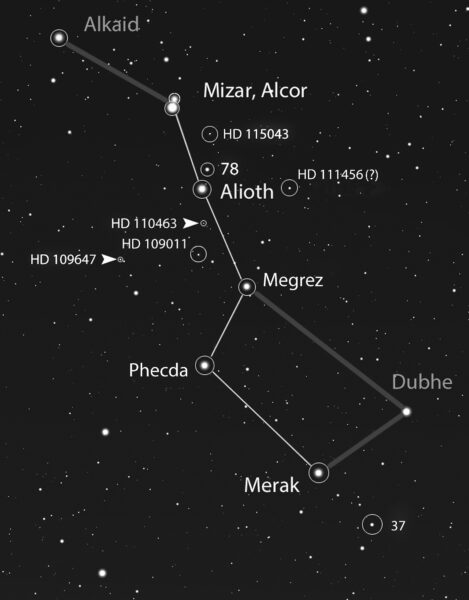
Stellarium with additions by Bob King
To see the Dipper best, lie on your back and look straight up. In late May, it stands almost directly overhead at nightfall. If you mentally block out Dubhe and Alkaid you're looking at the core of a weakly bound star cluster that includes an additional seven stars, three of which are visible with the naked eye and the others in 50-mm binoculars or a small telescope. With an overall magnitude of +0.4, Collinder 285 is one of the brightest stellar moving group in the sky and also the closest.
| Name | Constellation | Distance (l-y) | Magnitude |
| Alioth | Ursa Major | 83 | 1.8 |
| Mizar A | Ursa Major | 83 | 2.2 |
| Merak | Ursa Major | 80 | 2.4 |
| Phecda | Ursa Major | 83 | 2.4 |
| Megrez | Ursa Major | 81 | 3.3 |
| Mizar B | Ursa Major | 83 | 3.9 |
| Alcor | Ursa Major | 82 | 4.0 |
| 78 UMa | Ursa Major | 83 | 4.9 |
| 37 UMa | Ursa Major | 87 | 5.1 |
| HD 111456 | Ursa Major | 85 | 5.8 |
| HD 115043 | Ursa Major | 82 | 6.8 |
| HD 109011 | Ursa Major | 83 | 8.1 |
| HD 110463 | Ursa Major | 74 | 8.3 |
| HD 109647 | Canes Venatici | 86 | 8.5 |
An additional 18 outliers share the cluster's motion for a total of 31 stars that have received a definitive "Yes" on the membership list compiled by Clemson University astronomer Jeremy King in his Ursa Major Moving Group survey published in 2003 in the Astronomical Journal. They include notable bright stars Alpha (α) Corona Borealis (a.k.a. Alphecca), Beta (β) Serpentis, and Zeta (ζ) Triangulum Australis. There are an additional 28 likely members (marked as "Yes?" with a question mark) for a total of 59. Despite its scantiness the Group extends from deep in the Southern Hemisphere almost to the North Celestial Pole.
Born inside a dense cloud of gas and dust roughly 500 ± 100 million years ago, the future Ursa Major Group formed a compact open cluster in Cambrian skies, a time when life rapidly diversified in the world's oceans and the first plants set root on land. A 2014 spectroscopic survey showed that many of the stars display a similar chemical composition — further evidence of a shared origin.
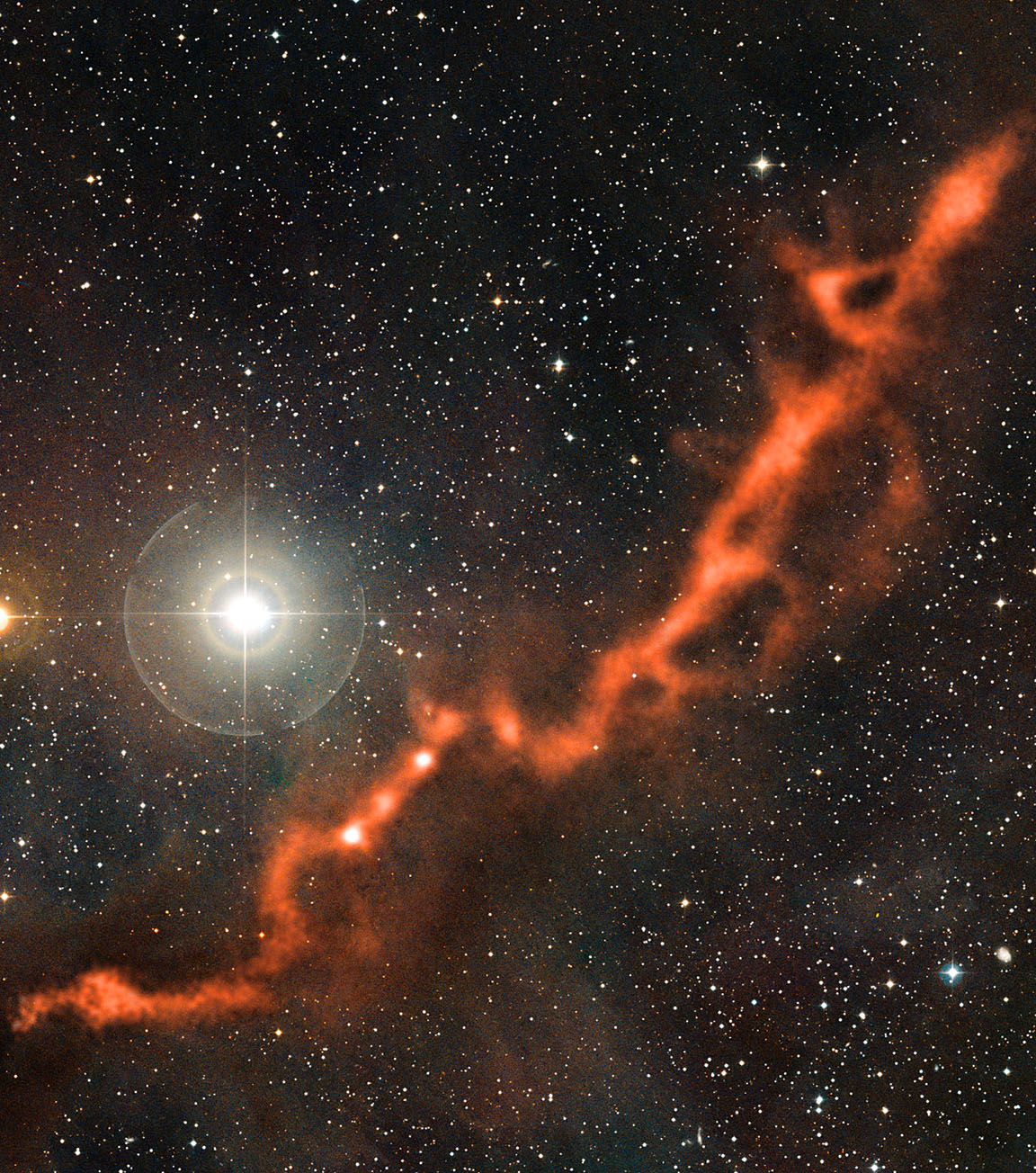
ESO / APEX (MPIfR / ESO / OSO) / A. Hacar et al. / Digitized Sky Survey 2. Acknowledgment: Davide De Martin
Open star clusters have lifetimes measured in the hundreds of millions of years before gravitational tides from passing molecular clouds of gas and dust pry them apart. In our era, we're witnessing the Group's transition from a self-contained cluster to a future of anonymity as field stars.
A typical open cluster's core might measure 3 to 4 light-years across; the Ursa Major Moving Cluster currently spans 30 light-years long by 18 light-years wide. And the whole works is flying through space together at 14 km/s (31,300 mph) towards a common point in the direction of the constellation Sagittarius. In about a million years, it will pass about 51 light-years from the solar system.
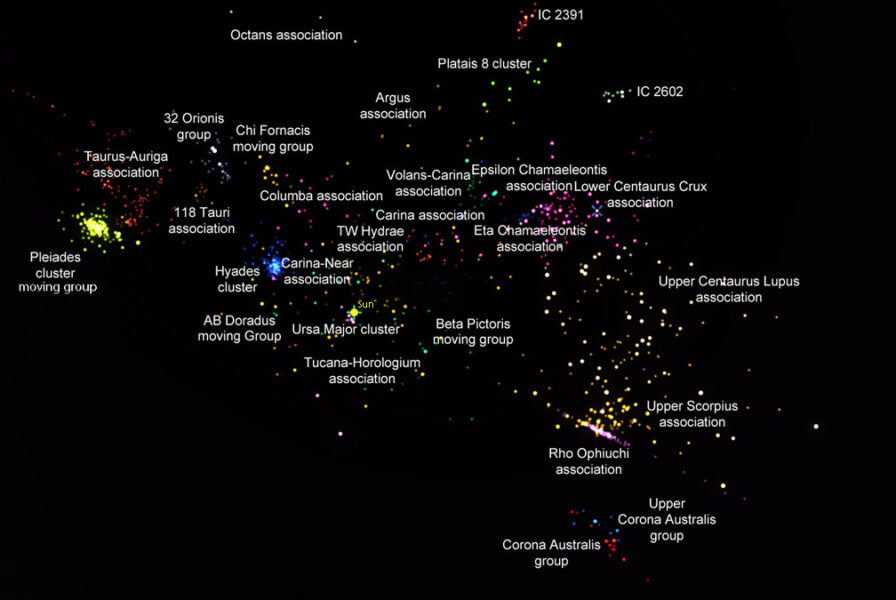
Meli Thev / CC BY-SA 4.0
Like schools of fish across the world's oceans, stellar streams are on the move throughout the galaxy. Ursa Major's cohorts include the AB Doradus Moving Group, located about 65 light-years away in Dorado with around 37 members, as well as the Beta (β) Pictoris Moving Group (28 stars 115 light-years away in Pictor). Stars in each pack share a common motion, age, and distance and remain in touch despite the best the galaxy has thrown at them.
 11
11









Comments
Anthony Barreiro
May 26, 2022 at 9:20 pm
After I first started seriously skywatching 22 years ago, it took two or three years to get a fairly decent grasp on the constellations. Then it dawned on me that the stars are not just points of light on the celestial sphere, they exist in three-dimensional space. Learning the constellations is easy by comparison; to learn where all those stars are in relation to the Sun and the larger structure of the galaxy you have to study and understand some astronomy. But even rudimentary knowledge of our stellar neighborhood is immensely satisfying, it makes my sense of "home" much bigger!
All that said, I keep looking at the map of the nearby moving groups and stellar associations, and I can't completely make sense of it. I can see one axis from Orion / Taurus / Auriga to Scorpius / Ophiuchus / Corona Australis, but the other two axes are harder to decipher. I wish I could spin the map around to see it from different angles. It would probably help if I knew the southern constellations too!
You must be logged in to post a comment.
Bob KingPost Author
May 27, 2022 at 1:19 pm
Hi Anthony,
I share your mind-bending experience in trying to visualize these streams. What we really need are 3-D maps or holograms — something you could view from different angles in space. Even a red-blue 3-D anaglyph would help enormously. 2-D is just 2-Difficult.
You must be logged in to post a comment.
ggunhouse
November 11, 2022 at 5:01 pm
I've experimented with making such a thing on sketchfab. I'm not sure my trigonometry is right (it would be great is someone could correct me if it's not), but I'll risk postingg this quick-and-dirty first draft:
https://sketchfab.com/3d-models/bigdipper-37c9c9ba615646aebf1497bc89fd35ad
You must be logged in to post a comment.
Bob KingPost Author
November 11, 2022 at 5:42 pm
Hi ggun,
That is truly amazing! One you get the geometry confirmed, sketchfab could be an amazing resource for 3-D visualization of the constellations. It's nice that it's interactive. One thing for sure is correct — the difference between Mizar and Alkaid in relation to the cluster. Thank you for sharing this.
You must be logged in to post a comment.
ggunhouse
November 12, 2022 at 9:10 am
Thanks. Making these things is quick and easy, *if* you know all the relative distances. It's surprising to me that sketchfab is not already full of them.
You must be logged in to post a comment.
ggunhouse
November 12, 2022 at 4:28 pm
I've checked the distances against those given in in your article and made everything in my model match what's published here. The interstellar distances match those given in John Mosley's comment below. I wasn't too far off to begin with, I'm happy to say, but the current version is more accurate. I have made it public on Sketchfab: https://sketchfab.com/3d-models/the-stars-of-the-big-dipper-37c9c9ba615646aebf1497bc89fd35ad
You must be logged in to post a comment.
John-Mosley
May 27, 2022 at 4:46 pm
SkySafari will let you do this. For example, from Alioth, Mizar is magnitude -3 and 7.2 light years distant while Alkaid is mag -1.0 and 27 light years distant, and 78 UMa is mag -3.7 at 1.5 light years (its companion is mag 7.9 at 0.5" separation). There is a map.
You must be logged in to post a comment.
Bob KingPost Author
May 27, 2022 at 7:37 pm
Thanks, John! I almost bought Sky Safari this past winter. Now you've given me another reason to purchase. Can you tell me what it gives for Mizar to Phecda?
You must be logged in to post a comment.
Brian
May 27, 2022 at 7:52 am
Great article but it leaves me with more questions than answers!
1. From our perspective, the brightest stars are all 80-83 ly away, 3 ly difference. If you could spin the map 90 degrees in either axis, are they also 3 ly apart? Closer? Farther? Which 2 would be 3 ly apart from our perspective? In other words: What does 3 ly from 80 ly look in our sky?
2. Are we (the sun) moving in the same direction as Alkaid & Dubhe & the Ursa group is moving in the opposite direction?
Or are we moving the same direction as Ursa & it only appears like the other 2 stars are moving in the opposite direction because they are farther away (think being in a moving car looking at near tree vs. far hill)?
You must be logged in to post a comment.
Bob KingPost Author
May 27, 2022 at 1:13 pm
Hi Brian,
What great questions! I'll try my best to answer:
1. Although the group's core the stars lie at somewhat different distances from one another, I can't find information on those particulars. But just looking at their positions in the Dipper, the separation between Phecda and Merak is considerably larger than say, Mizar and Alioth. Assuming identical distances from Earth, the distances between those stars in 3-D space would clearly vary. But given that they're all about the same distance from Earth and lie near one another in the sky, they're still spatially close.
In the bigger picture, Alpha CrB (Alphecca) is also member of the cluster (on the outskirts, away from the core) at a distance of 75 l-y. So even though it lies at approximately the same distance as the core group, its apparent distance from the core is huge. The group is so spread out and covers so much sky because it's a box measuring 30x18 light-years, making it difficult to visualize in three dimensions.
I wonder if you couldn't use trigonometry to calculate inter-star distances? I played around with this visual angle calculator (https://elvers.us/perception/visualAngle/) and assumed identical distances for the core stars. If I used it correctly, it gave the Mizar-to-Alioth distance as about 6 light-years and the Megrez-to-Phecda distance as 11 light-years. Maybe you'd like to try it, too.
2. The radial velocities of all the group members are negative, meaning they're all moving toward us as a group. That's how we know Dubhe and Alkaid aren't members because they don't share that motion. Group members also have the same proper motion — velocity across the line of sight — which the Sun doesn't share. As its members converge toward Sagittarius they'll pass us at 46 kilometers per second. I hope this helps. If not, just ask.
You must be logged in to post a comment.
Kevan Hubbard
May 28, 2022 at 6:12 pm
I always thought that Orion's Belt was a dispersed cluster too but maybe I got the wrong end of the stick at some point as I see Alnitak and Mintaka are a similar distance around a huge 1200 LY away but Alnilam is a massive,mind even 1 LY is massive!,2000 LY away....Deneb distances.First Noculluient Clouds of the season last night,27th May about 23hr,to digress ,but too many tropospheric clouds tonight....a mixture of Stratocumulus and high Cirrus.
You must be logged in to post a comment.
You must be logged in to post a comment.